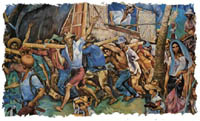|
Why Artistic Genius Can Be Found
in the Hinterlands of Davao and Isabela
...Or Designing Art Programs for the Masses
When the first post-EDSA administration of the Cultural Center of the Philippines (CCP) established
coordinating centers for the arts, it was guided by principles of Filipinization and decentralization. With an artistic director
and several coordinating center and department heads coming from the ranks of the Concerned Artists of the Philippines (CAP),
an umbrella organization of artists and cultural workers that identified itself with the forces that worked for the downfall
of the Marcos regime which established the CCP in 1969, the new management supported the clamor for a pro-people artistic
orientation.
With the help of consultants from the various regions, the Center for Literature modified some pre-EDSA
projects and established new programs. The literary contest, later called “Gawad CCP para sa Panitikan”, was focused
on works written in Filipino. Libretto writing was added as a category to encourage writers to create for the stage. In addition,
a literary grants program was institutionalized to give financial assistance to writers in the different Philippine languages
as well as technical services like venues and workshops to national and regional writers groups. It conducted fora and symposia,
dubbed as the “Huntahan” series, on artistic/literary and socio-political issues, with local and foreign writers
and cultural personalities as panelists.
Sometimes, in the “Huntahan”, it presented to the public for the first time literary works in
progress. Its literary journal, ANI, published works in Philippine languages, with translations in Filipino or English. Each
volume featuring a collection of works in a Philippine language had an editorial board composed of writers writing in that
regional language. Launchings of ANI were held in regions whose languages were featured in respective volumes of the journal.
This way, writers who heretofore did not have an outlet for their works and were unrecognized were given incentives they deserved.
Because of financial contraints, the establishment of the National Commission for Culture and the Arts (NCCA)
as the coordinating center for culture and the arts in 1992, and the shift in priorities of CCP as the country’s performing
arts center, the literary contest and the literary grants program were discontinued in 1996. “Huntahan” was converted
into a seminar program to provide a means by which writers and readers, students and teachers in the provinces could have
a dialog on their works and the creative process. The program later came to be known as “Kathaan” as participants
in the regions expressed interest in creating new works in their own languages, harnessing their local folklore, history and
experiences.
“Kathaan” would later pave the way for a partnership system between CCP and the local communities
serving as hosts and beneficiaries of what have evolved as sharing cum writing and performance workshops in the regions. The
Literature Division would bring the workshop kits to the locality, the writer-resource persons who would conduct the sharing
cum workshop as well as the certificates of attendance to be given to the participants at the end of the workshop. CCP would
also take charge of national publicity and documentation. The local host organization, which may be a school, writers’
organization, community art council or local government unit, would take charge of the participants, venues, local publicity,
food, and accommodations for the resource persons and CCP staff. This counterparting system would prove to be a viable means
by which partnership between local groups and CCP could develop for the cause of culture and art.
The Coordinating Center for Literature was eventually renamed the Literature Division. With the dissolution
in 1995 of the Visual, Literary and Media Arts (VLMA) under which department the coordinating center belonged since 1986,
it was lumped with Film and Broadcast, Cultural Promotions, and Outreach and Exchange Divisions under the new Cultural Exchange
and Communication Services Department (CECSD). The Literature Division had, aside from the ANI journal, three new programs:
“Tanghal-Tula”, “Batang-Sining” and “An Evening of Poetry and Music”. With the help of
the Outreach and Exchange Division, the Literature Division gained new partners as both divisions joined forces in touring
workshops through the “Lakbay-Sining” program in 1998 in celebration of the centennial of Philippine Independence.
The “Tanghal-Tula” workshops reached Cagayan Capitol College in Cagayan de Oro city; Central Mindanao University
(CMU) in Musuan, Bukidnon; Brokenshire Hospital in Davao City; Marawi city; Iloilo National High School in Iloilo city; and
Malolos, Bulacan.
TANGHAL-TULA: Discipline through metaphorical language (continue...)
|

